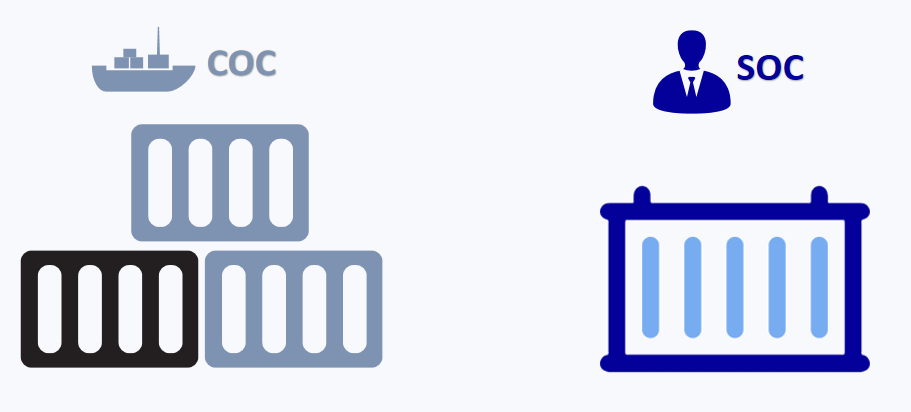Understanding COC and SOC: What's Their Difference

Understanding COC and SOC
In the logistics and shipping industry, containers are a critical component of cargo transportation. There are two primary types of containers used in shipping: Carrier Owned Containers (COC) and Shipper Owned Containers (SOC). Both types serve the same purpose but differ in ownership and usage scenarios.
What is COC (Carrier Owned Container)?
A Carrier Owned Container (COC) is owned and maintained by the shipping line. When shippers book their cargo with a carrier, they often use COC for convenience, especially when working with fcl services that rely on a streamlined container supply..
Advantages of COC:
- Availability: Easily accessible through shipping lines.
- Maintenance Responsibility: The carrier manages maintenance and repair.
- Simplified Process: Convenient for one-time or less frequent shippers.
Disadvantages of COC:
- Demurrage and Detention Charges: High costs if containers are delayed.
- Limited Flexibility: Restricted to the carrier’s network and policies.
What is SOC (Shipper Owned Container)?
A Shipper Owned Container (SOC) is owned by the shipper or a leasing company. Shippers have full control over the container's use and are not reliant on the carrier's container inventory.
Advantages of SOC:
- Avoid Demurrage and Detention: No extra charges for delays.
- Greater Flexibility: Can be used across multiple carriers and routes.
- Customized Solutions: Containers can be modified for specific cargo needs, and container loading planner tools are often used to optimize space. .
Disadvantages of SOC:
- Initial Investment: Higher upfront costs to purchase or lease.
- Maintenance Responsibility: The shipper is responsible for repairs and upkeep.
- Logistics Complexity: Requires coordination for repositioning and storage.
When to Choose COC or SOC?
- COC is Ideal for:
- Small shipments or infrequent shipping needs.
- Situations where convenience is prioritized over cost control.
- Areas where container availability is limited to carriers.
- SOC is Ideal for:
- Large-scale or frequent shipments.
- Shipping to areas with high demurrage risks.
- Customized shipping requirements or specialized cargo, especially in complex sea freight projects..
Conclusion
Understanding the differences between COC and SOC is vital for optimizing logistics operations. Choosing the right container type depends on factors like cost, flexibility, and specific shipping needs. Businesses—especially those working with a freight forwarder —should assess their logistics strategies to determine which option aligns best with their goals.
Real-World Applications: Who Uses COC & SOC?
Different industries and logistics needs dictate the preference for COC or SOC containers:
- E-commerce businesses often opt for COC containers to streamline operations, especially for standardized shipping routes with frequent port access.
- Construction and industrial project teams choose SOC containers for remote site delivery, on-site storage, or when timelines are unpredictable.
- Freight forwarders managing lcl shipments sometimes mix both types—COC for efficiency on major lanes, SOC for flexibility where carrier container availability is limited.
Cost Breakdown: COC vs. SOC
Here’s a quick comparison of cost implications for each container type:
| Cost Factor | COC (Carrier-Owned) | SOC (Shipper-Owned) |
|---|---|---|
| Upfront Container Cost | Included in freight rate | Shipper pays purchase or lease costs |
| Demurrage & Detention | Risk of high fees if delayed | Avoided (no carrier-imposed deadlines) |
| Container Return Process | Must return to designated depot | Shipper-controlled return or reuse |
| Maintenance Responsibility | Carrier-managed | Shipper-managed |
| Flexibility & Routing | Restricted to carrier’s schedule | Full routing flexibility |
SOC may involve higher initial costs, but over time, it can reduce operational risks and provide more freedom—particularly for large-volume or delayed deliveries.
Can You Switch Between COC and SOC?
Yes, businesses often switch between COC and SOC depending on the cargo type, shipping route, and delivery location. For example:
- Use COC for fast-moving consumer goods with predictable lead times.
- Use SOC for project-based cargo that requires longer unloading or flexible positioning.
Being flexible allows companies to respond to changes in carrier availability, port congestion, or destination-specific regulations.
Choosing SOC? Here's What You Need to Manage
If you decide to use SOC containers, be prepared to handle logistics tasks typically managed by the carrier when using COC. Key responsibilities include:
- Container Procurement: Purchase or lease containers suited to your cargo type.
- Maintenance Oversight: Regular inspection and repair scheduling.
- Positioning & Tracking: Coordinate pickup, drop-off, and repositioning of empty containers.
- Load Optimization: Use a container loading calculator to plan efficient space usage and minimize cargo damage.
Choosing SOC gives you more control, but it also requires more hands-on coordination and cost tracking.
Frequently Asked Questions
-
Can I use SOC containers for international shipping across multiple carriers?
Yes. SOCs offer flexibility across carrier networks, making them ideal for global, multi-leg shipments.
-
Is SOC suitable for small businesses?
It depends. SOC can be cost-effective in certain scenarios, but small businesses must consider the added complexity and responsibilities.
-
What container type is better for one-time shipments?
COC is usually preferred for one-time or infrequent shipments due to its simplicity and carrier-managed process.

